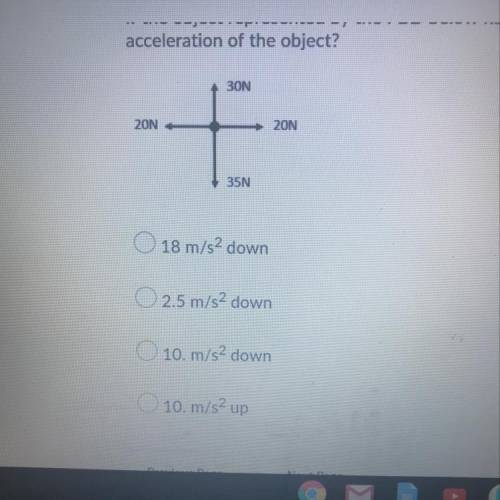
Physics, 20.06.2020 11:57 imamador6396
If the object represented by the FBD below has a mass of 2.0 kg, what is the acceleration of the object?


Answers: 3
Another question on Physics

Physics, 21.06.2019 19:10
What happens to light waves from a star as the star moves away from earth?
Answers: 3

Physics, 21.06.2019 22:50
Two horizontal plates with infinite length and width are separated by a distance h in the z direction. the bottom plate is moving at a velocity u. the incompressible fluid trapped between the plates is moving in the positive x-direction with the bottom plate. align gravity with positive z. assume that the flow is fully-developed and laminar. if the systems operates at steady state and the pressure gradient in x-direction can be ignored, do the following: 1. sketch your system 2. identify the coordinate system to be used. 3. show your coordinates and origin point on the sketch. list all your assumptions. 5. apply the continuity equation to your system. nts of navier stokes equations of choice to your system 7. solve the resulting differential equation to obtain the velocity profile within the system make sure to list your boundary conditions. check units of velocity 8. describe the velocity profile you obtain using engineering terminology. sketch that on the same sketch you provided in (1). 9. obtain the equation that describes the volumetric flow rate in the system. check the units.
Answers: 2

Physics, 22.06.2019 06:20
Oxygen undergoes an isentropic expansion from 120 degree c and 280 kpa absolute to 140 kpa absolute. determine the final temperature of the oxygen and the amount of work per kg of o_2 produced in the process if it is adiabatic.
Answers: 1

Physics, 22.06.2019 17:30
Asilver dollar is dropped from the top of a building that is 1324 feet tall. use the position function below for free-falling objects. s(t) = −16t2 + v0t + s0 (a) determine the position and velocity functions for the coin. s(t) = v(t) = (b) determine the average velocity on the interval [1, 2]. ft/s (c) find the instantaneous velocities when t = 1 second and t = 2 seconds. v(1) = ft/s v(2) = ft/s (d) find the time required for the coin to reach the ground level. (round your answer to three decimal places.) t = s (e) find the velocity of the coin at impact. (round your answer to three decimal places.) ft/s
Answers: 3
You know the right answer?
If the object represented by the FBD below has a mass of 2.0 kg, what is the
acceleration of the ob...
Questions

Computers and Technology, 02.12.2019 23:31

Mathematics, 02.12.2019 23:31


Health, 02.12.2019 23:31


History, 02.12.2019 23:31






Mathematics, 02.12.2019 23:31

Mathematics, 02.12.2019 23:31




History, 02.12.2019 23:31

Mathematics, 02.12.2019 23:31




